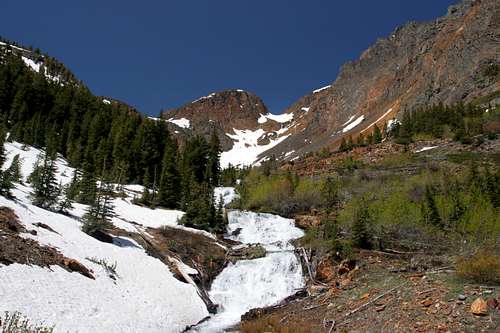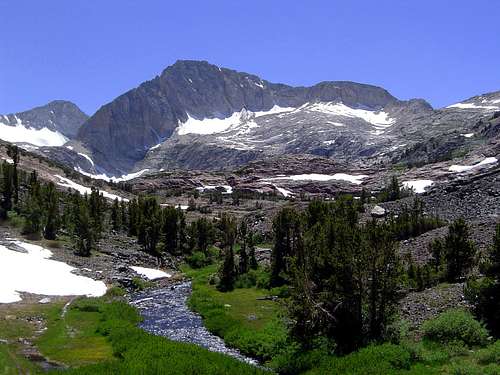-
 23280 Hits
23280 Hits
-
 89.01% Score
89.01% Score
-
 28 Votes
28 Votes
|
|
Canyon |
|---|---|
|
|
38.01152°N / 119.28183°W |
|
|
Hiking, Scrambling |
|
|
Summer, Fall |
|
|
Overview
While there are many magnificent canyons along the eastern escarpment of the Sierra Nevada, few present such awesome scenery in such an easily packaged bundle as found in Lundy Canyon. Many of the best aspects of the Sierra Nevada are found here: soaring cliffs, rugged peaks, gorgeous meadows, riotous wildflowers, excellent waterfalls, and, once the Twenty Lakes Basin is reached, spectacular granite summits and glacial lakes. All of this can be accessed with relative ease off of a major highway. While such beauty has not gone unnoticed, Lundy Canyon is nonetheless relatively uncrowded, particularly by Yosemite (which is located only a few miles west of Lundy Canyon) standards. Solitude is still a quality the characterizes the canyon, particularly if one travels off trail to Burro Lake, or once one begins the climb up to the Twenty Lakes Basin.
While many of Lundy Canyon’s attractions are found in other parts of the Sierra Nevada, there are a few attributes that distinguish it from many of the more typical Sierra regions. First, the walls of the canyon are composed of metamorphic rock rather than the granite that is a hallmark of the Sierra Nevada. The cliffs are a colorful collage of reds, grays and blacks. Another distinguishing characteristic of Lundy Canyon is the proliferation of aspens. While these trees are found in pockets throughout the range, particularly in the Eastern Sierra, few places boast such an abundance of aspen trees. These two attributes combine to give Lundy Canyon a feel that is in some ways resembles the San Juan range in Colorado more than the Sierra Nevada. Nonetheless, when one climbs out of the canyon and enters into the Twenty Lakes Basin with its glaciers, glacial polished peaks and granite rimmed lakes, it is impossible to confuse which mountain range Lundy Canyon is found in.
Another unusual aspect of Lundy Canyon is the wildlife. While all of the usual Sierra suspects are found here to varying degrees, the sizable presence of beavers is a noticeable departure from most Sierra wildlife communities. The lower canyon has three massive beaver ponds that resemble lakes more than artificial bodies of water. It is amazing to think that a very industrial rodent created these fake lakes. Nonetheless, the presence of the beaver ponds does contribute to the beauty of Lundy Canyon, particularly since the canyon has no natural lakes beneath its walls. Additional smaller beaver ponds are found further up the canyon in addition to the larger pools. It is not unusual to find felled aspen trees with the traditional conical stump when hiking through Lundy Canyon. It has been reported that the beavers are not native to the area but were introduced into the canyon. Although this claim is unconfirmed, the beavers presence has certainly altered the appearence of Lundy Canyon by the development of the complex network of dams and the resultant ponds.
Three superlatives are usually used when describing Lundy Canyon. Many say that the canyon has the Eastern Sierra’s best waterfalls, wildflowers and fall color. The abundant aspen and leaves little doubt that fall is a spectacular time in the canyon. The numerous lush meadows host excellent wildflower displays, columbine being particular productive. Lundy Canyon’s waterfalls are some of the best in the Sierra. Mill Creek, which forms the main waterway through the canyon, has two particularly large cataracts on it, one near the beginning of the trail and another near the point where the trail begins to climb out of the canyon. Massive cascades tumble down the sides of the canyon as well. The most notable of these is the outlet falls coming from Burro Lake, which is nestled in a high glacial cirque on the north side of the canyon and the falls the flows out of the Twenty Lakes Basin, near the western end of the canyon.
Lundy Canyon was once the site of extensive mining activity. The best evidence of this is found near the trailhead, where the ruins of a large structure and a pump are lost amid the dense aspens. No trail leads to these ruins, but a bit of bushwhacking out of the southern side of the trailhead parking lot will lead to them. An old cabin is found along the trail, in between the two primary falls on Mill Creek. Even the name of the creek indicates the mining that once took place in the canyon. Other mining ruins can be found around Oneida Lake, which is located in a massive cirque on the south side of the lower canyon. Another important legacy of the canyon’s mining history is the trail that leads from the canyon floor to the Twenty Lakes Basin.
Hoover Wilderness
Lundy Canyon is found in the southern section of the Hoover Wilderness. The wilderness area contains 48,601 acres of the eastern Sierra. It shares nearly 22 miles of Yosemite’s northeast boundary. The area is a mixture of metamorphic rock and glaciated granite. The metamorphic areas are generally found in the lower elevations while the granite dominates the high country. Several small glaciers are found in the wilderness, notably on the slopes of Mt. Conness, Matterhorn Peak and Dunderberg. The northern terminus of the wilderness area is near Sonora Pass, while the southern terminus is marked by Tioga Pass. The Hoover Wilderness is the northern most wilderness area in the High Sierra, which is generally considered at an end at Matterhorn Peak, the northern most 12,000 foot peak in the Sierra Nevada. The Hoover Wilderness includes the northern face of Matterhorn Peak.
Getting There
From Lee Vining drive north on Highway 395 for roughly 7 miles. At a signed intersection turn left onto Lundy Lake Road. The intersection is signed at difficult to miss. Drive west 5 miles to Lundy Lake Resort. The road travels above Lundy Lake, which is an impoundment on Mill Creek. The resort is rustic and offers cabins and campsites. At the resort, the pavement ends and the road continues another 1.5 miles to the trailhead. The dirt road is in good condition and it easy for sedans to reach the trailhead. Numerous parking spots are found off a loop at the trailhead.
Red Tape
Lundy Canyon is located in the Hoover Wilderness. Normal wilderness rules and ethics apply. A permit is required for camping in the wilderness area.
Inyo National Forest
351 Pacu Lane
Suite 200
Bishop, CA 93514
760-873-2400
Mono Basin Scenic Area
Ranger Station & Visitor Center
P.O. Box 429
Lee Vining, CA 93541
760-647-3044
Camping
A US Forest Service campground is located at the eastern end of Lundy Lake. The Lundy Lake Resort also offers good campsites. Dispersed camping is permitted at the trailhead (which has an outhouse) as well as in the wilderness area.









